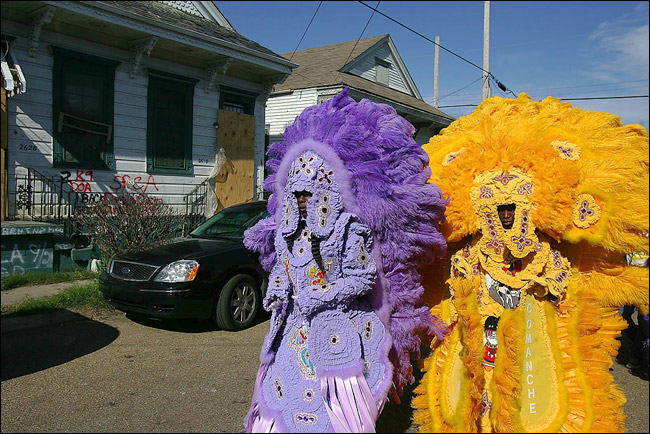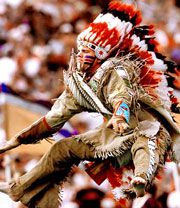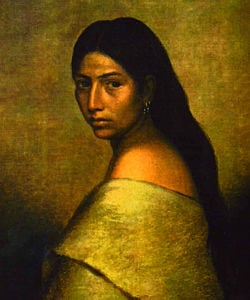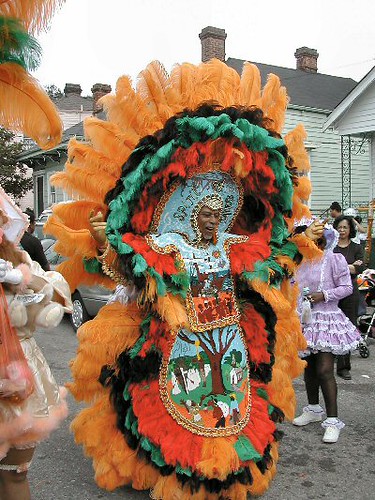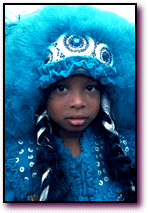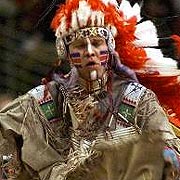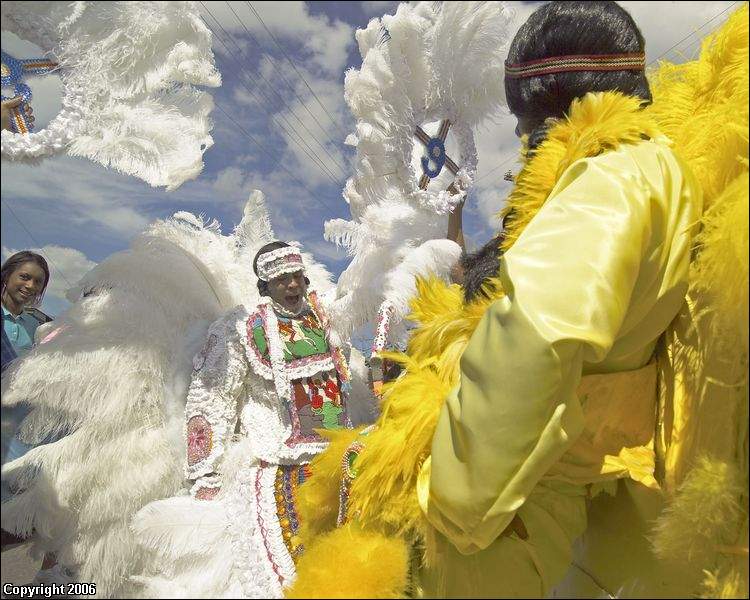A new HBO series about New Orleans features the Mardi Gras Indians:
In 'Treme', Race and Class Loom LargeBy Latoya PetersonEach character appears to serve a different purpose outside of the story, with many vocalizing contemporary issues in New Orleans. For example, Albert Lambreaux is fascinating for a variety of reasons, one being his representation of different life stages. While he is currently a respected member of the community and a pillar of tradition, the events in the second episode hint at a less virtuous path to his current position. Lambreaux is also the neighborhood's resident "chief"--a title conferred due to his involvement with the Mardi Gras Indians. As Lambreaux struggles to pull together the members of his "tribe" before Mardi Gras and Super Sunday (St. Joseph's day), outsiders are treated to an interesting historical footnote: the exact origins of the Mardi Gras Indians tradition are not known, but most inception stories trace the practice to the intermingling of black and Indigenous peoples during the slavery era and the growth of the tradition as an homage to shared culture and solidarity.
Adrienne Keene, of the Native Appropriations blog, discusses the aspects of both appropriation and respect that inform the longstanding tradition:
Inherent in the concept of cultural appropriation is the notion of power. The group in power takes cultural aspects of a subordinate community out of context and uses them how they see fit. These Mardi Gras Indians are African American, and arguably at the lowest economic strata of society (the NYTimes article talks about copyrighting as a means to recoup money for these performers). They are by no means in a position of power over Native communities in Louisiana or elsewhere. The Mardi Gras Indian culture does not appear to come out of a desire to "play Indian," and in many ways, it has moved outside of the realm of cultural appropriation into a distinct culture and community of it's own. But above all, it seems the history comes not out of a relationship of power, but out of a shared position of marginality and discrimination.
Considering that many people are not aware that Mardi Gras celebrations were ever segregated, the display of a notably black tradition and references to NOLA's indigenous peoples on HBO is a major coup.Comment: I say the Mardi Gras krewes
are playing Indian. Their reasons may be a little deeper than most, but they're still adopting stereotypical names and costumes that have nothing to do with their Southern Indian heritage.
These people are supposedly honoring the tribes who took in their ancestors--e.g., the Choctaw. If that's so, why not name and dress themselves like Choctaws? What do the showgirl outfits and the goofy names like Yellow Pocahontas have to do with the actual Indians who saved them?
Even
mascot lovers usually get that much right. If they're "honoring" Plains
chiefs, they dress like Plains chiefs. They don't dress like Indians from New York, Florida, or California.
Indians and Blacks equal?Peterson and Keene float similar theories based on blacks and Indians being together at the bottom of New Orleans society. Like sisters, blacks and Indians could share clothes because they shared a history. Neither group had any power, so the dress-up game wasn't a power trip.
Since no one knows the krewes' history for sure, let me float my own theory.
In New Orleans's mixed society, blacks weren't just slaves and beggars. They were seeded throughout the lower, middle, and even some of the upper classes. In contrast, Indians truly lived on the margins of New Orleans society. They were equal to the poorest blacks, yes, but many blacks weren't poor.
So blacks dressing as Indians in the Mardi Gras sent the same message it sends in every other context. The same message that whites send when they dress up as Wampanoag Indians in
Thanksgiving pageants. Namely:
Even though you helped us, we ended up ahead of you. We have more power and status and we're glad of it. Because we can dress up as you, we will dress up as you. Like any Westerners who dress up in tribal costumes or fashions, our message is: "We won. We're better than you. We can pretend to be savages because we're civilized."
Where are the real Indians?If you don't think this is going on, show me some genuine American Indians dressed in stereotypical African American costumes. Show me some blacks dressed as outlandish "blacks" or Indians dressed as outlandish "Indians." Show me some real Indians, period.
If these two groups are expressing their mutual marginalized history, where are the real Indians and the phony blacks? Why does the mimicry go in only one direction? Where exactly is the sharing in this "shared" history?
Then there are the
Mayokis and
Chasco "Indian" krewes in Florida--white people who do the same thing as the black people of New Orleans. Not to mention all the white
Halloween parties and
YMCA-style programs across the nation. These whites don't have the same shared history with Indians, so what's their excuse for playing dress-up?
You're telling me blacks and whites both play-act as Indians, but it's just a coincidence? One is a genuine expression of history and the other is a complete mockery? I don't think so.
I won't even go into how the "Indian" krewes compete for fame and fortune. If they've ever shared a jot of
Louisiana Indian lore, I must've missed it. The Mardi Gras is all about getting oneself recognized, not recognizing others.
Appropriation isn't an honorHere are some valid choices for the
Mardi Gras Indians:
1) If you're honoring real Indians, dress like real Indians. For instance, if you're honoring all Indians, dress like a variety of real-world Indians. Don't dress only in stereotypical Plains clothes.
Similarly, if you're honoring Louisiana Indians, don't dress like Las Vegas showgirls. Dress like Louisiana Indians. Duh.
2) If you're dressing like fake Indians, don't claim you're honoring real Indians. This applies to most mascot lovers, Mardi Gras krewes, and other
Indian wannabes.
We don't honor George Washington by dressing up as King George III. Or Abraham Lincoln by dressing up as John Wilkes Booth. Dressing up as the wrong Indians is just as stupid as dressing up as the wrong Europeans.
3) If you can't dress like the Indians you're supposedly honoring, don't bother trying. You're just going to trivialize or bastardize the people you claim to admire.
Try honoring Louisiana's Indians with awards or artwork, not phony names and costumes. Try giving
to them, not taking
from them. (Mis)appropriating someone's culture and history isn't an honor.
For more on the subject, see
Exploitation Upsets Mardi Gras Exploiters and
Debating the Hokey Mayokis.
Below: A scene from
Treme.



